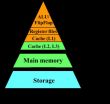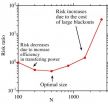(Press-News.org) Glucosamine has been freely available in drugstores for many decades. It is widely used to treat arthritis and to prevent joint degeneration. Moreover, glucosamine is known to delay cancer growth. In addition, glucosamine reduces metabolism of nutritive sugars, as was already shown some 50 years ago.
In 2007, Michael Ristow showed that too much nutritive sugar shortens the lifespan of roundworms, a widely studied model organism in ageing research. Conversely, impairing carbohydrate metabolism in these worms was capable of extending lifespan [reference 1]. Unfortunately, the method used in worms at that time unexpectedly appeared to be ineffective in rodents [reference 2], and hence was not studied further.
Extended lifespan by almost 10%
In the recently published study that was performed at ETH Zurich and four German research institutions, Ristow and his colleagues applied glucosamine to roundworms and found that they live around 5% longer than their untreated counterparts.
Next and most importantly, the researchers fed glucosamine to ageing mice in addition to their normal diet. The mice were 100 weeks of age, reflecting a comparative human age of approximately 65 years. A control group of mice received no glucosamine while otherwise receiving an identical diet. Feeding the supplement to mice extended their lifespan by almost 10%, reflecting around 8 additional years of human lifespan. Moreover, glucosamine improved glucose metabolism in elderly mice indicating protection from diabetes, a life-threatening disease most prevalent amongst the elderly.
Mimicking a low-carb diet
Additional analyses revealed that glucosamine feeding promotes the breakdown of amino acids in both worms and mice. Amino acids are key components of proteins, and they become preferentially metabolized in the absence of carbohydrates. As Ristow points out, "this reflects the metabolic state of a low-carb diet due to glucosamine supplementation alone – while these mice ingested the same amount of carbohydrates as their unsupplemented counterparts." This implies that glucosamine would mimic a low-carb diet in humans as well – without the necessity of reducing the uptake of carbohydrates in our daily diet.
Should we now start taking glucosamine supplements? Ristow replies: "This may be considered a valid option, and yes, I have started taking glucosamine myself." However, he points out that "diabetics should perform tight blood glucose control, especially during the first weeks." Interestingly, two recent epidemiological studies on more than 77,000 individuals suggest that intake of glucosamine supplements is associated with reduced mortality in humans [references 3, 4]. "Unlike with our longer living mice, such an association is no definite proof of the effectiveness of glucosamine in humans", says Ristow. He continues, "But the chances are good, and since unlike with most other potentially lifespan-extending drugs there are no known relevant side effects of glucosamine supplementation, I would tend to recommend this supplement."
INFORMATION:
Original publication:
Sandra Weimer et al.: D-Glucosamine supplementation extends lifespan of nematodes and of ageing mice. Nature Communications, 2014, doi: 10.1038/ncomms4563,
Creative Commons Free Access: http://dx.doi.org/10.1038/ncomms4563
Additional references:
1. Schulz, T.J., et al., Glucose restriction extends Caenorhabditis elegans life span by inducing mitochondrial respiration and increasing oxidative stress. Cell Metab, 2007. 6(4): p. 280-293,
http://dx.doi.org/10.1016/j.cmet.2007.08.011
2. Minor, R.K., et al., Chronic ingestion of 2-deoxy-D-glucose induces cardiac vacuolization and increases mortality in rats. Toxicol Appl Pharmacol, 2010. 243(3): p. 332-9,
http://dx.doi.org/10.1016/j.taap.2009.11.025
3. Pocobelli, G., et al., Total mortality risk in relation to use of less-common dietary supplements. Am J Clin Nutr, 2010. 91(6): p. 1791-800, http://dx.doi.org/10.3945/ajcn.2009.28639
4. Bell, G.A., et al., Use of glucosamine and chondroitin in relation to mortality. Eur J Epidemiol, 2012. 27(8): p. 593-603,
http://dx.doi.org/10.1007/s10654-012-9714-6
Glucosamine promotes longevity by mimicking a low-carb diet
Life-prolonging effect of a commonly used food supplement in worms and mice
2014-04-08
ELSE PRESS RELEASES FROM THIS DATE:
Future computers that are 'normally off'
2014-04-08
WASHINGTON D.C., April 8, 2014 -- If a research team in Japan gets its wish, "normally off" computers may one day soon be replacing present computers in a move that would both eliminate volatile memory, which requires power to maintain stored data, and reduce the gigantic energy losses associated with it.
Most parts of present computers are made with volatile devices such as transistors and dynamic random access memory (DRAM), which loses information when powered off. So computers are designed on the premise that power is "normally on."
Back in 2000, the concept of ...
Is the power grid too big?
2014-04-08
WASHINGTON D.C., April 8, 2014 -- Some 90 years ago, British polymath J.B.S. Haldane proposed that for every animal there is an optimal size -- one which allows it to make best use of its environment and the physical laws that govern its activities, whether hiding, hunting, hoofing or hibernating. Today, three researchers are asking whether there is a "right" size for another type of huge beast: the U.S. power grid.
David Newman, a physicist at the University of Alaska, believes that smaller grids would reduce the likelihood of severe outages, such as the 2003 Northeast ...
Rice U. study: Creativity and innovation need to talk more
2014-04-08
HOUSTON – (April 8, 2014) – Creativity and innovation are not sufficiently integrated in either the business world or academic research, according to a new study by Rice University, the University of Edinburgh and Brunel University.
The findings are the result of the authors' review of the rapidly growing body of research into creativity and innovation in the workplace, with particular attention to the period from 2002 to 2013.
"There are many of us who study employee creativity and many of us who study innovation and idea implementation, but we don't talk to each ...
The surprising truth about obsessive-compulsive thinking
2014-04-08
Montreal, April 8, 2014 — People who check whether their hands are clean or imagine their house might be on fire are not alone. New research from Concordia University and 15 other universities worldwide shows that 94 per cent of people experience unwanted, intrusive thoughts, images and/or impulses.
The international study, which was co-authored by Concordia psychology professor Adam Radomsky and published in the Journal of Obsessive-Compulsive and Related Disorders, examined people on six continents.
Radomsky and his colleagues found that the thoughts, images and ...
Where credit is due: How acknowledging expertise can help conservation efforts
2014-04-08
Scientists know that tapping into local expertise is key to conservation efforts aimed at protecting biodiversity – but researchers rarely give credit to these local experts. Now some scientists are saying that's a problem, both for the local experts and for the science itself.
To address the problem, a group of scientists is calling for conservation researchers to do a better job of publicly acknowledging the role of local experts and other non-scientists in conservation biology.
"For example, in the rainforests of the Yucatán, scientists couldn't even begin to do ...
Blocking DNA repair mechanisms could improve radiation therapy for deadly brain cancer
2014-04-08
DALLAS – April 8, 2014 – UT Southwestern Medical Center researchers have demonstrated in both cancer cell lines and in mice that blocking critical DNA repair mechanisms could improve the effectiveness of radiation therapy for highly fatal brain tumors called glioblastomas.
Radiation therapy causes double-strand breaks in DNA that must be repaired for tumors to keep growing. Scientists have long theorized that if they could find a way to block repairs from being made, they could prevent tumors from growing or at least slow down the growth, thereby extending patients' survival. ...
What songbirds tell us about how we learn
2014-04-08
This news release is available in French. When you throw a wild pitch or sing a flat note, it could be that your basal ganglia made you do it. This area in the middle of the brain is involved in motor control and learning. And one reason for that errant toss or off-key note may be that your brain prompted you to vary your behavior to help you learn, from trial-and-error, to perform better.
But how does the brain do this, how does it cause you to vary your behavior?
Along with researchers from the University of California, San Francisco, Indian Institute of Science ...
NASA satellite sees Tropical Depression Peipah approaching Philippines
2014-04-08
As Tropical Depression Peipah continues moving toward the central Philippines, NASA's Aqua satellite passed overhead and took an infrared look at the cloud top temperatures for clues about its strength.
On April 8 at 05:11 UTC/1:11 a.m. EDT/11 p.m. Manila local time, the Atmospheric Infrared Sounder instrument known as AIRS gathered infrared data on Tropical Depression Peipah. AIRS is one of the instruments that flies aboard NASA's Aqua satellite. The AIRS data showed thunderstorms with very cold cloud-top temperatures surrounded the center of the low-level circulation ...
Intranasal ketamine confers rapid antidepressant effect in depression
2014-04-08
A research team from the Icahn School of Medicine at Mount Sinai published the first controlled evidence showing that an intranasal ketamine spray conferred an unusually rapid antidepressant effect –within 24 hours—and was well tolerated in patients with treatment-resistant major depressive disorder. This is the first study to show benefits with an intranasal formulation of ketamine. Results from the study were published online in the peer-reviewed journal Biological Psychiatry on April 2, 2014.
Of 18 patients completing two treatment days with ketamine or saline, eight ...
DNA modifications measured in blood signal related changes in the brain
2014-04-08
Johns Hopkins researchers say they have confirmed suspicions that DNA modifications found in the blood of mice exposed to high levels of stress hormone — and showing signs of anxiety — are directly related to changes found in their brain tissues.
The proof-of-concept study, reported online ahead of print in the June issue of Psychoneuroendocrinology, offers what the research team calls the first evidence that epigenetic changes that alter the way genes function without changing their underlying DNA sequence — and are detectable in blood — mirror alterations in brain tissue ...
LAST 30 PRESS RELEASES:
Tracing the quick synthesis of an industrially important catalyst
New software sheds light on cancer’s hidden genetic networks
UT Health San Antonio awarded $3 million in CPRIT grants to bolster cancer research and prevention efforts in South Texas
Third symposium spotlights global challenge of new contaminants in China’s fight against pollution
From straw to soil harmony: International team reveals how biochar supercharges carbon-smart farming
Myeloma: How AI is redrawing the map of cancer care
Manhattan E. Charurat, Ph.D., MHS invested as the Homer and Martha Gudelsky Distinguished Professor in Medicine at the University of Maryland School of Medicine
Insilico Medicine’s Pharma.AI Q4 Winter Launch Recap: Revolutionizing drug discovery with cutting-edge AI innovations, accelerating the path to pharmaceutical superintelligence
Nanoplastics have diet-dependent impacts on digestive system health
Brain neuron death occurs throughout life and increases with age, a natural human protein drug may halt neuron death in Alzheimer’s disease
SPIE and CLP announce the recipients of the 2025 Advanced Photonics Young Innovator Award
Lessons from the Caldor Fire’s Christmas Valley ‘Miracle’
Ant societies rose by trading individual protection for collective power
Research reveals how ancient viral DNA shapes early embryonic development
A molecular gatekeeper that controls protein synthesis
New ‘cloaking device’ concept to shield sensitive tech from magnetic fields
Researchers show impact of mountain building and climate change on alpine biodiversity
Study models the transition from Neanderthals to modern humans in Europe
University of Phoenix College of Doctoral Studies releases white paper on AI-driven skilling to reduce burnout and restore worker autonomy
AIs fail at the game of visual “telephone”
The levers for a sustainable food system
Potential changes in US homelessness by ending federal support for housing first programs
Vulnerability of large language models to prompt injection when providing medical advice
Researchers develop new system for high-energy-density, long-life, multi-electron transfer bromine-based flow batteries
Ending federal support for housing first programs could increase U.S. homelessness by 5% in one year, new JAMA study finds
New research uncovers molecular ‘safety switch’ shielding cancers from immune attack
Bacteria resisting viral infection can still sink carbon to ocean floor
Younger biological age may increase depression risk in older women during COVID-19
Bharat Innovates 2026 National Basecamp Showcases India’s Most Promising Deep-Tech Ventures
Here’s what determines whether your income level rises or falls
[Press-News.org] Glucosamine promotes longevity by mimicking a low-carb dietLife-prolonging effect of a commonly used food supplement in worms and mice





